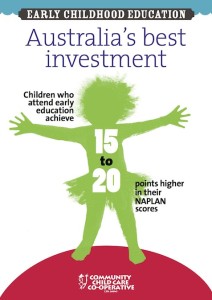These next few weeks are all about numbers. And with the biggest number cruncher, the May Budget, only a fortnight away, there has been plenty of speculation about what Prime Minister Tony Abbott’s cost-cutting government is going to deliver.
Top of the list is the PM’s signature (and much criticised) six-month paid parental leave scheme, which today he agreed to scale back to incomes up to $100,000, not $150,000 as was promised in the lead up to the election.
So what will happen to the money saved? Most likely, not a lot. Given that the scheme was to be funded, in part, by big business tax increases, they’re likely to be the winners from the change. Besides, it’s unlikely there will be any real savings from the change because so few women earn above $100,000.

This infographic from Community Child Care Co-operative (NSW) is just one of their many resources highlighting the importance of early education and care. (Click on the image to see more.)
Whatever the savings, though, instead of any gold-plated PPL scheme, aimed at getting more women back into the workforce, the PM should be directing funds to initiatives that will actually be able to help families getting back into the workforce: better funding for childcare.
‘ECA supports an improved paid parental leave scheme, but it won’t have much effect on workforce participation without a quality early learning sector’, said Samantha Page, CEO of Early Childhood Australia (ECA).
One way is by making childcare tax deductible, though this would likely benefit high income earners rather than low income earners. ‘A huge majority of families would be thousands of dollars out of pocket if a tax deductible system was introduced’, said Page.
‘Tax deductibility is a seductive idea but it would severely impact on low income families, who have the most to gain from a quality, affordable early childhood education,’ she added.
According to ECA, if tax-deductible childcare was introduced in place of current parent subsidies, families a household income of $55,000 per year would be worse off by over $9,000 per year, and a family earning $155,000 per year would lose $2,875.
Instead, Page is calling for a ‘simplified, uncapped system that has more weighting for low income families would remove the complexity plaguing the subsidies we currently have’.
For now*, the nation’s most disadvantaged wait to find out how deep the cuts will run.
Making sense of the numbers
And if you need some more numbers, here are a few worth paying close attention to, from Harvard University’s Center on the Developing Child:
700: the number of neural connections formed every second in the early years.
18: the age, in months, at which disparities in vocabulary begin to appear.
90-100: the percentage chance of developmental delays when children experience 6-7 risk factors.
3:1: the odds of adult heart disease after 7-8 adverse childhood experiences.
4–9: the dollar returns for every dollar invested in early childhood programs.
*UPDATE: Although the Budget is a couple of weeks away, the Commission of Audit report, released 1 May, gives us a better idea of what might follow on the 13th. The report is a little troubling, and Community Child Care Co-operative (NSW) offers its take on how the recommendations will affect the early education sector here.



No Comments Yet